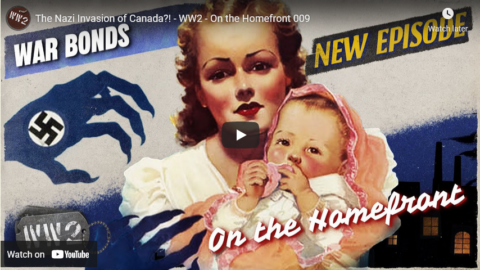World War Two
Published 6 May 2021What would happen if Nazi Germany invaded Canada? You don’t need to imagine. In 1942, the government of Mackenzie King launched a propaganda effort that simulates Canada falling under Hitler’s yoke. Why? For the war economy of course!
Join us on Patreon: https://www.patreon.com/TimeGhostHistory
Or join The TimeGhost Army directly at: https://timeghost.tvFollow WW2 day by day on Instagram @ww2_day_by_day – https://www.instagram.com/ww2_day_by_day
Between 2 Wars: https://www.youtube.com/playlist?list…
Source list: http://bit.ly/WW2sourcesHosted by: Anna Deinhard
Written by: Fiona Rachel Fischer and Spartacus Olsson
Director: Astrid Deinhard
Producers: Astrid Deinhard and Spartacus Olsson
Executive Producers: Astrid Deinhard, Indy Neidell, Spartacus Olsson, Bodo Rittenauer
Creative Producer: Maria Kyhle
Post-Production Director: Wieke Kapteijns
Research by: Fiona Rachel Fischer
Edited by: Miki Cackowski
Sound design: Marek Kamiński
Map animations: Miki Cackowski and Eastory (https://www.youtube.com/c/eastory)Colorizations by:
Adrien Fillon – https://www.instagram.com/adrien.colo…
Daniel WeissSources:
IWM Art.IWM PST 18495, CH 27, CH 3231, CH 6831, HU 88386, HU 104482
nationaal archief
Photo Album of F.V. Light (1923-2000)Soundtracks from the Epidemic Sound:
Howard Harper-Barnes – “London”
Johannes Bornlof – “The Inspector 4”
Howard Harper-Barnes – “Prescient”
Max Anson – “Ancient Saga”
Howard Harper-Barnes – “Sailing for Gold”
Philip Ayers – “Please Hear Me Out”
Jo Wandrini – “Puzzle Of Complexity”
Reynard Seidel – “Deflection”
Rannar Sillard – “March Of The Brave 4”
Phoenix Tail – “At the Front”Archive by Screenocean/Reuters https://www.screenocean.com.
A TimeGhost chronological documentary produced by OnLion Entertainment GmbH.
From the comments:
World War Two
1 day ago
As you can see in the video, the efforts to raise money to pay for the war were extremely high. But when we read about the stuff that was going on in Winnipeg on “If-Day”, we were really surprised — talk about “playing” war! Of course, this top-notch high-effort propaganda had quite the impact on the citizens of Winnipeg, because — let´s be honest — who wouldn´t be frightened by any kind of Nazi invasion? And they did not spare any effort to get the details right, too. What is your impression of If-Day? Have you heard of it before? Please let us know in the comments!Cheers, Fiona
P.S. If you want to watch the short film starring Donald Duck which Anna mentions in the video, click right here: https://www.youtube.com/watch?v=XNMrMFuk-bo&ab_channel=8thManDVD.com%E2%84%A2CartoonChannel







